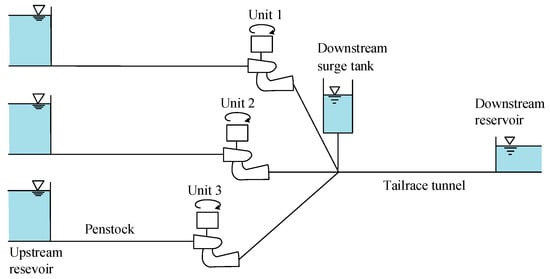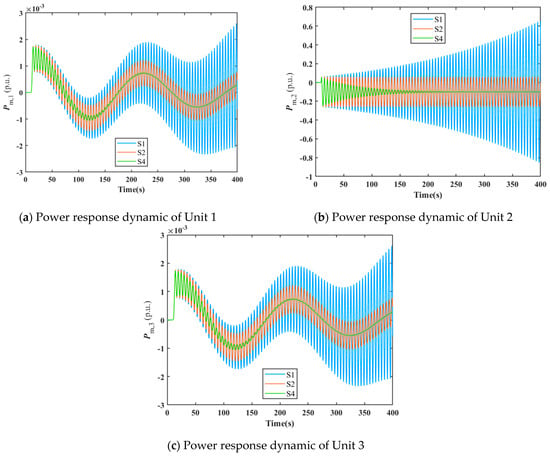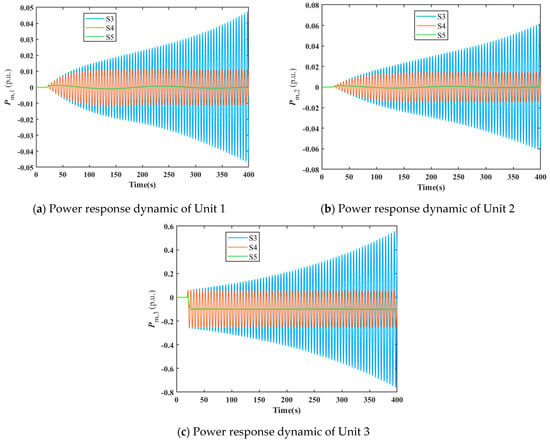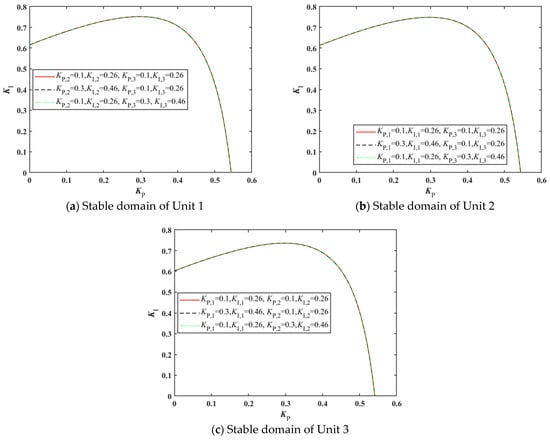Abstract
As a key power source for peak regulation and frequency control, hydropower units frequently adjust their output to maintain grid stability. In shared tailrace tunnel systems, hydraulic coupling between units significantly influences system stability. This study investigates a three-unit system with a common tailrace tunnel, establishes its mathematical model, and employs linear stability analysis to examine its stability characteristics under small disturbances. The research focuses on the impacts of total power output and power allocation strategies on system stability. Key findings reveal that (1) the stable domain of each unit decreases with greater penstock water inertia, and the instability of any single unit propagates through hydraulic coupling, causing system-wide instability; (2) the control parameters of individual units primarily affect their own stability, with negligible cross-unit impact, and the system’s overall stable domain is determined by the unit with the smallest stability region when uniform parameters are adopted; (3) increasing the total power output reduces system stability, and equally distributing power among units is more conducive to stable operation than concentrating it on a single unit. These results provide a theoretical basis for the optimized dispatch and stability control of multi-unit hydropower systems with shared hydraulic structures.
1. Introduction
As a widely recognized high-quality renewable energy source, hydropower plays a vital role in the green and low-carbon energy transition []. Under the pressing challenge of large-scale integration of highly intermittent renewables like wind and solar, the power system demands more from flexible regulation resources []. Hydropower, with its rapid response and large storage capacity, stands out as a cornerstone for grid stability []. It not only supplies substantial clean electricity but also provides regulation functions, offering firm capacity support for the development of new power systems []. In the context of large-scale and high-penetration renewable energy integration, hydropower’s role in performing flexible regulation tasks greatly enhances the absorption of renewables and helps ensure the secure, stable operation of the power grid [,]. The critical position of hydropower in the future power landscape will become increasingly prominent, and the impact of hydropower plant stability on power system reliability continues to grow [].
The advancement of modern hydroelectric power stations is reflected not only in increased generator capacity but also in the heightened complexity of their hydraulic systems []. In practical applications, hydropower plants are typically configured with multiple units sharing common water conveyance pipelines, where both electrical and hydraulic interactions exist among the units [,,]. This makes the operational characteristics of multi-unit systems more complex than those of single-unit systems [,,]. Consequently, it is essential to analyze the stability of multi-unit systems holistically by considering their interconnections, as this aligns with engineering reality.
At present, researchers primarily employ numerical simulation and theoretical analysis methods to investigate the dynamic stability of multi-unit hydropower systems with shared penstocks []. Existing research can be broadly divided into two categories. The first category has used numerical modeling to study hydraulic coupling effects and hydro-mechanical–electrical interactions during hydraulic disturbances in multi-unit systems with a common water conveyance pipeline [,,,,,]. These studies reveal the influence of factors such as guide vane control strategies, penstock length, and grid-connection modes on the dynamic characteristics of multi-unit systems. Another category has also applied theoretical approaches, such as Hopf bifurcation theory, to examine the stability of multi-unit systems with common tailrace tunnels [,,,,,], clarifying the impact of typical hydraulic, mechanical, and electrical parameters on system stability.
While these studies have provided valuable insights from hydraulic, mechanical, and electrical perspectives, a common limitation persists. They largely assume uniform operating conditions or equal power sharing among units. In reality, however, power distribution among units is often non-uniform due to operational efficiency, maintenance schedules, or dispatch requirements. The critical question of how this power allocation strategy affects the system’s small-signal stability remains largely unexplored, creating a significant gap between theoretical analysis and practical operation.
Accordingly, this paper establishes a detailed dynamic model of a multi-unit system with a common tailrace tunnel based on an actual large-scale hydropower plant. The model integrates the hydraulic dynamics of the shared tunnel, the turbine characteristics, and the governor system. Employing linearization and eigenvalue analysis, this study systematically investigates the small-signal stability of the system. The core of the work is to analyze the stability variations under different total power output levels and, more importantly, under different unit power allocation schemes. The main contribution of this paper is the systematic investigation and revelation of the impact of unit power allocation on the small-signal stability of multi-unit hydropower plants. The findings provide theoretical support for operational optimization of similar multi-unit hydropower systems.
4. The Impact of Unit Power Output on System Stability
Hydropower units possess flexible regulation capabilities and can ensure the secure and stable operation of the grid by participating in peak shaving. During the peak shaving process of hydropower units, changes in unit power output are important factors affecting system operational characteristics. To investigate the impact of varying unit power levels on system stability, the stable domains for each unit under four power conditions, i.e., 0.6 pu, 0.7 pu, 0.8 pu, and 0.9 pu, are plotted for Units 1, 2, and 3 operating at identical power levels, as illustrated in Figure 6. The symbols SD1, SD2, SD3, and SD4 retain their previously defined meanings.
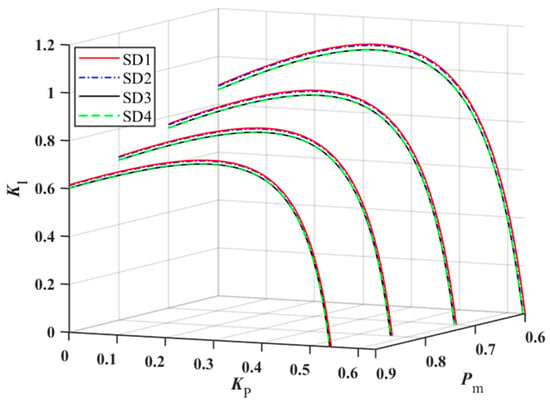
Figure 6.
Stable domains of the three-unit shared tailrace system under different power output levels.
As shown in Figure 6, the stable domains of Units 1, 2, and 3 all decrease with increasing power output, and the relative sizes of the stable domains for the three units remain unchanged. Simultaneously, when the governor control parameters for all three units are kept consistent, the stable domain of the three-unit system also decreases with increasing power output. Moreover, at different power output levels, this stable domain is essentially identical to that of Unit 3, further validating the conclusions drawn in Section 3. The aforementioned results indicate that increased power across all three units exerts a detrimental effect upon their respective stability.
Furthermore, the impact of different power allocation schemes on the stability of the three-unit shared tailrace tunnel system is investigated. For convenience of analysis, the minimum stable domain ensuring stable parameters for all units is considered, i.e., the stable domain of the three-unit system when the governor control parameters of all three units remain consistent. When the initial powers of Units 1, 2, and 3 are all set to 0.6 pu, there are 10 possible allocation methods for adding 0.3 pu of power to the entire three-unit system, as shown in Table 2. The stable domains of the three-unit system under these ten different power allocation schemes are depicted in Figure 7.

Table 2.
Power allocation schemes for Units 1, 2 and 3 with a 0.3 pu power increase in the three-unit system.
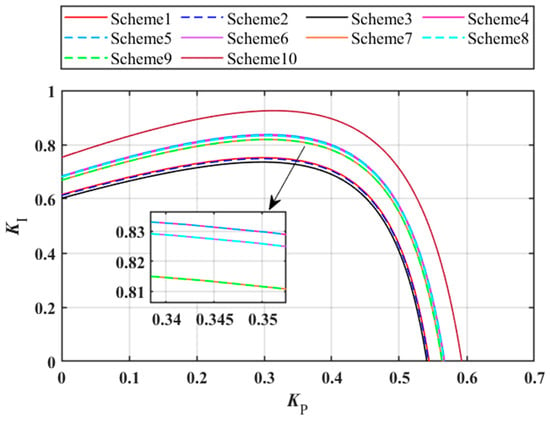
Figure 7.
Stable domain of the three-unit system under different power allocation schemes.
As shown in Figure 7, the three-unit system stable domain is smallest when Scheme 3 allocates 0.3 pu power to Unit 3. The stable domains for the three-unit system under Schemes 1 and 2, which allocate 0.3 pu power to Units 1 and 2, respectively, are slightly larger than those under Scheme 3. Schemes 4 and 5 both allocate 0.2 pu power to Unit 1, yielding essentially identical three-unit system stable domains. Similarly, Schemes 6 and 8, which allocate 0.2 pu power to Unit 2, produce nearly identical stable domains. Likewise, Schemes 7 and 9, allocating 0.2 pu power to Unit 3, result in substantially comparable stable domains. The stable domains of the three-unit system corresponding to the above three sets of schemes decrease sequentially but remain larger than those of the first three schemes. Scheme 10, which evenly distributes 0.3 pu power among Units 1, 2, and 3, yields the largest stable domain for the three-unit system. This demonstrates that when increasing power in a three-unit shared tailrace tunnel system, distributing power evenly among units is more conducive to stable system operation.
5. Discussion
The mathematical model and stability analysis results are discussed in this section. This study extends the single-machine single-tunnel system to a multi-machine shared-tunnel scenario, establishing a model that essentially represents an extension and optimization of the IEEE hydro-generator unit model. Although this model exhibits limited accuracy compared to [], its theoretical foundation remains consistent, thereby facilitating the analysis of hydraulic coupling characteristics within multi-machine systems. Previous studies have examined the stability characteristics of multi-unit hydroelectric systems, but few have considered them from the perspective of coupling effects and power allocation. This study establishes that system stability arises from the combined effects of ‘single-machine stability’ and ‘coupled disturbances’, with single-machine stability forming the foundation. It further reveals that the influence of multi-machine governor control parameters on the stability domain exhibits weak coupling, facilitating engineering tuning. Moreover, it clarifies that uniform power distribution constitutes the optimal operating strategy for maintaining stability in multi-machine systems.
The limitations of this paper are discussed as follows:
The paper employs a pipeline model based on rigid water hammer theory, which neglects complex hydraulic phenomena. Consequently, its dynamic description of the shared tailrace tunnel may be overly idealized. The study assumes that the three units are identical or share consistent characteristics. In practice, the dynamic properties of turbines within the system exhibit variations, potentially necessitating a revision of the conclusion regarding ‘optimal uniform power distribution’.
The model assumes an infinitely large grid, whereas in reality, hydroelectric power stations are connected to finite grids. The grid’s strength, load characteristics, and interactions with other generators significantly influence the system’s oscillation modes and damping. Future work must account for grid interactions: extending the model to scenarios involving grid connections to investigate the mutual influence between power system oscillations and hydraulic system oscillations.
Moreover, it is crucial to conduct engineering validation of the model by collecting operational data from actual power stations for calibrating and verifying the established mathematical model, thereby ensuring the model accurately reflects the dynamic characteristics of the real system.
6. Conclusions
This paper establishes a mathematical model for the hydro-turbine governor system of the three-unit shared tailrace tunnel. Based on this model, linear stability analysis methods are employed to investigate system operational stability. The study primarily examines the impact of varying power output levels and power allocations on the stability of the three-unit system. The main conclusions are as follows:
- (1)
- A key finding of this research is the identification of a system-wide instability mechanism in coupled hydro-unit systems. We have demonstrated that under power disturbances, instability in any single unit—particularly those with larger penstock water inertia—can propagate through the shared hydraulic coupling and destabilize the entire system. This reveals a “bucket effect” where the system’s overall stability is constrained by its least stable unit, providing critical insight for system design and protection strategy formulation.
- (2)
- This paper reveals the weak coupling characteristic of governor parameters in multi-unit shared tailrace systems. Specifically, adjustments to one unit’s control parameters have a negligible impact on the stable domains of other units. This important finding significantly simplifies the parameter tuning process in practical engineering.
- (3)
- This study confirms that the power output variation in units significantly impacts the stability of the three-unit shared tailrace tunnel system. An increase in power output across all three units adversely affects their respective stability. A key finding is that, when allocating power within a three-unit system, allocating the majority of the additional power to a single unit is detrimental to stable operation. Conversely, distributing the power evenly across all units is more conducive to maintaining system stability.
This paper contributes to the optimized operation of multiple units within the common hydraulic system of hydroelectric power stations. Future work may address the limitations discussed in Section 5.
Author Contributions
D.L.: original draft, methodology, data curation, supervision, funding acquisition. Y.X.: writing—review and editing. J.L.: investigation, formal analysis. X.T.: writing—review and editing, supervision. All authors have read and agreed to the published version of the manuscript.
Funding
This article was funded by the National Natural Science Foundation of China (Grant Nos. 52309111, 52509120) and the 2024 Open Research Foundation of Hubei Key Laboratory of Digital River Basin Science and Technology.
Data Availability Statement
The original contributions presented in this study are included in the article. Further inquiries can be directed to the corresponding author.
Conflicts of Interest
The authors declare that they have no known competing financial interests or personal relationships that could have appeared to influence the work reported in this paper.
Appendix A
References
- Yang, W.; Norrlund, P.; Saarinen, L.; Witt, A.; Smith, B.; Yang, J. Burden on hydropower units for short-term balancing of renewable power systems. Nat. Commun. 2018, 9, 2633. [Google Scholar] [CrossRef] [PubMed]
- Jiang, H.; Yao, L.; Qin, J.; Bai, Y.; Brandt, M.; Lian, X.; Davis, S.; Lu, N.; Zhao, W.; Liu, T.; et al. Globally interconnected solar-wind system addresses future electricity demands. Nat. Commun. 2025, 16, 4523. [Google Scholar] [CrossRef] [PubMed]
- Wang, S.; Li, F.; Zhang, G.; Yin, C. Analysis of energy storage demand for peak shaving and frequency regulation of power systems with high penetration of renewable energy. Energy 2023, 267, 126586. [Google Scholar] [CrossRef]
- Luo, X.; Huang, L.; Sui, X. Capacity optimization of existing reservoir hydropower expansion and its impact on power system flexibility. Appl. Energy 2025, 377, 124549. [Google Scholar] [CrossRef]
- Liu, B.; Lund, J.R.; Liao, S.; Jin, X.; Liu, L.; Cheng, C. Optimal power peak shaving using hydropower to complement wind and solar power uncertainty. Energy Convers. Manag. 2020, 209, 112628. [Google Scholar] [CrossRef]
- Danso, D.K.; François, B.; Hingray, B.; Diedhiou, A. Assessing hydropower flexibility for integrating solar and wind energy in West Africa using dynamic programming and sensitivity analysis. Illustration with the Akosombo reservoir, Ghana. J. Clean. Prod. 2021, 287, 125559. [Google Scholar] [CrossRef]
- Xu, R.; Tan, X.; Wang, H.; Zhu, Z.; Lu, X.; Li, C. Stability of hydropower units under full operating conditions considering nonlinear coupling of turbine characteristics. Renew. Energy 2024, 223, 120009. [Google Scholar] [CrossRef]
- Yang, W.; Norrlund, P.; Chung, C.Y.; Yang, J.; Urban, L. Eigen-analysis of hydraulic-mechanical-electrical coupling mechanism for small signal stability of hydropower plant. Renew. Energy 2017, 115, 1014–1025. [Google Scholar] [CrossRef]
- Liu, Z.; Yan, Z.; Zhang, H.; Xie, H.; Zou, Y.; Zheng, Y.; Xiao, Z.; Chen, F. Suppression and Analysis of Low-Frequency Oscillation in Hydropower Unit Regulation Systems with Complex Water Diversion Systems. Energies 2024, 17, 4831. [Google Scholar] [CrossRef]
- Xu, B.; Wang, F.; Chen, D.; Zhang, H. Hamiltonian modeling of multi-hydro-turbine governing systems with sharing common penstock and dynamic analyses under shock load. Energy Convers. Manag. 2016, 108, 478–487. [Google Scholar] [CrossRef]
- Wang, F.; Zeng, Y.; Qian, J. Nonlinear modelling and design of synergetic controllers for single penstock multi-machine hydropower system. Electr. Power Syst. Res. 2024, 234, 110584. [Google Scholar] [CrossRef]
- Han, J.; Chen, D.; Zhang, H. Stability of multi-hydro-turbine governing time-delay systems with sharing tailrace surge tank. J. Vibroeng. 2018, 20, 2734–2744. [Google Scholar] [CrossRef]
- Dao, F.; Zou, Y.; Zeng, Y.; Qian, J.; Li, X. An intelligent CPSOGSA-based mixed H2/H∞ robust controller for the multi-hydro-turbine governing system with sharing common penstock. Renew. Energy 2023, 206, 481–497. [Google Scholar] [CrossRef]
- Rangi, S.; Jain, S.; Arya, Y. Utilization of energy storage devices with optimal controller for multi-area hydro-hydro power system under deregulated environment. Sustain. Energy Technol. Assess. 2022, 52, 102191. [Google Scholar] [CrossRef]
- Xu, B.; Zhang, J.; Egusquiza, M.; Chen, D.; Li, F.; Behrens, P.; Egusquiza, E. A review of dynamic models and stability analysis for a hydro-turbine governing system. Renew. Sust. Energy Rev. 2021, 144, 110880. [Google Scholar] [CrossRef]
- Li, H.; Chen, D.; Xu, B.; Tolo, S.; Patelli, E. Dynamic analysis of multi-unit hydropower systems in transient process. Nonlinear Dyn. 2017, 90, 535–548. [Google Scholar] [CrossRef]
- Liu, D.; Li, C.; Malik, O.P. Nonlinear modeling and multi-scale damping characteristics of hydro-turbine regulation systems under complex variable hydraulic and electrical network structures. Appl. Energy 2021, 293, 116949. [Google Scholar] [CrossRef]
- Lei, L.; Li, F.; Kheav, K.; Jiang, W.; Luo, X.; Patelli, E.; Xu, B.; Chen, D. A start-up optimization strategy of a hydroelectric generating system: From a symmetrical structure to asymmetric structure on diversion pipes. Renew. Energy 2021, 180, 1148–1165. [Google Scholar] [CrossRef]
- Huang, Y.; Yang, W.; Liao, Y.; Zhao, Z.; Ma, W.; Yang, J.; Yang, J. Improved transfer function method for flexible simulation of hydraulic-mechanical-electrical transient processes of hydro-power plants. Renew. Energy 2022, 196, 390–404. [Google Scholar] [CrossRef]
- Liu, Y.; Yu, X.; Zhang, J.; Chen, S.; Zhang, Y. Optimized operation framework of pumped storage power stations with fixed-and variable-speed units sharing a diversion tunnel: Efficiency optimization and transient characteristics analysis. Energy 2025, 336, 138555. [Google Scholar] [CrossRef]
- Yu, X.; Zhou, Q.; Zhang, L.; Zhang, J. Hydraulic disturbance in multiturbine hydraulically coupled systems of hydropower plants caused by load variation. J. Hydraul. Eng. 2019, 145, 04018078. [Google Scholar] [CrossRef]
- Lai, X.; Huang, H.; Zheng, B.; Li, D.; Zong, Y. Nonlinear modeling and stability analysis of asymmetric hydro-turbine governing system. Appl. Math. Model. 2023, 120, 281–300. [Google Scholar] [CrossRef]
- Tang, R.; Yang, J.; Yang, W.; Zou, J.; Lai, X. Dynamic regulation characteristics of pumped-storage plants with two generating units sharing common conduits and busbar for balancing variable renewable energy. Renew. Energy 2019, 135, 1064–1077. [Google Scholar] [CrossRef]
- Guo, W.; Qu, F. Stability control of dynamic system of hydropower station with two turbine units sharing a super long headrace tunnel. J. Frankl. Inst. 2021, 358, 8506–8533. [Google Scholar] [CrossRef]
- Yang, X.; Lian, J.; Yu, X.; He, W. Critical stable cross-sectional area of surge tank in hydropower plant with multiple units sharing common hydraulic system. Int. J. Electr. Power Energy Syst. 2021, 131, 107067. [Google Scholar] [CrossRef]
- Lu, X.; Li, C.; Liu, D.; Zhu, Z.; Tan, X.; Xu, R. Comprehensive stability analysis of complex hydropower system under flexible operating conditions based on a fast stability domain solving method. Energy 2023, 274, 127368. [Google Scholar] [CrossRef]
- Chen, J.; Zhao, K.; Xu, Y.; Cao, H.; Liu, Y.; Li, S. Study on the stability and ultra-low frequency oscillation suppression method of pumped storage power plant with dual units sharing one pipeline. J. Energy Storage 2024, 98, 113156. [Google Scholar] [CrossRef]
- Guo, W.; Peng, Z. Hydropower system operation stability considering the coupling effect of water potential energy in surge tank and power grid. Renew. Energy 2019, 134, 846–861. [Google Scholar] [CrossRef]
- Peng, Z.; Guo, W. Saturation characteristics for stability of hydro-turbine governing system with surge tank. Renew. Energy 2019, 131, 318–332. [Google Scholar] [CrossRef]
- IEEE Working Group. Hydraulic turbine and turbine control models for system dynamic studies. IEEE Trans. Power Syst. 1992, 7, 167–179. [Google Scholar] [CrossRef]
- Liu, D.; Wang, X.; Peng, Y.; Zhang, H.; Xiao, Z.; Han, X.; Malik, O.P. Stability analysis of hydropower units under full operating conditions considering turbine nonlinearity. Renew. Energy 2020, 154, 723–742. [Google Scholar] [CrossRef]
Disclaimer/Publisher’s Note: The statements, opinions and data contained in all publications are solely those of the individual author(s) and contributor(s) and not of MDPI and/or the editor(s). MDPI and/or the editor(s) disclaim responsibility for any injury to people or property resulting from any ideas, methods, instructions or products referred to in the content. |
© 2025 by the authors. Licensee MDPI, Basel, Switzerland. This article is an open access article distributed under the terms and conditions of the Creative Commons Attribution (CC BY) license (https://creativecommons.org/licenses/by/4.0/).
